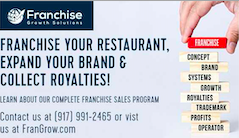Photo by Kaleidico on Unsplash
A strategic selling plan is not just a path to success; it separates thriving franchises from those that falter. It requires a comprehensive approach encompassing building a strong brand, executing a controlled and strategic expansion, choosing the right franchisees, making wise advertising investments, and managing a robust supply chain.
Why Having a Strategic Selling Plan is Vital to a Franchisor’s Success
By Johnny Dey
When launching a franchise company, a strategic selling plan is not just beneficial—it’s a necessity for a franchisor’s success. This strategy includes brand recognition, targeted expansion, ideal franchisee identification, advertising investment, and supply chain management. These components work in unison to ensure sustainable growth and brand consistency.
Brand Recognition: The Foundation of Franchise Success
Brand recognition is a pivotal component of a franchisor’s strategic selling strategy. It’s the cornerstone that sets the stage for all other aspects of franchise development. A strong brand is recognizable, evokes positive emotions, and is synonymous with quality in consumers’ minds. This recognition is essential for attracting potential franchisees who are more likely to invest in a brand that is already established and respected in the market.
Concentric Expansion: A Calculated Approach to Growth
One common misstep in franchising is the “shotgun” approach, where franchises are sold indiscriminately across vast geographical areas. This strategy often leads to logistical nightmares and dilutes brand presence. Instead, strategic expansion in concentric circles from the home base territory is recommended. This method ensures a controlled growth pattern, allowing the franchisor to maintain quality control and brand consistency. By growing outward from a solid central hub, franchisors can ensure that each new franchise is supported adequately and has the best chance of success.
Identifying the Perfect Franchisee
The success of a franchise heavily relies on the quality of its franchisees. The perfect franchisee is not just someone with the financial resources to invest but also someone who aligns with the brand’s values has a strong understanding of the local market, and possesses the drive to succeed. By identifying and partnering with these individuals, franchisors can ensure that their brand is represented appropriately and that each franchise is managed effectively.
Advertising Investment: Balancing Cost and Impact
Advertising plays a crucial role in the expansion of a franchise. However, determining how much should be spent on advertising is a delicate balance. Overspending can strain the franchisor’s resources while underspending can lead to inadequate market penetration. Franchisors must identify their target demographic’s most effective advertising channels and allocate resources accordingly. This investment promotes the brand and supports franchisees in their local market.
Supply Chain Management in Distant Markets
As franchises expand, supply chain management becomes increasingly complex, especially in far-away markets. Franchisors need to assess whether they can maintain a consistent supply chain that meets their quality standards and is cost-effective. This may involve developing new supplier relationships or adapting logistics strategies to suit different geographical areas. Efficient supply chain management is crucial to ensure that all franchises, regardless of location, can deliver the consistent quality that customers expect.
Conclusion
Any discussion on the success of a franchisor inevitably circles back to the pivotal role of a strategic selling strategy. This strategy is far from a mere set of guidelines; it is the blueprint for sustainable success in a competitive industry. It encapsulates a holistic approach that touches upon every facet of franchising, from the initial building of a recognizable and respected brand to the meticulous and strategic expansion of the franchise network.
First and foremost, brand recognition must be balanced. A brand is not just a logo or a slogan; it is the embodiment of the franchisor’s promise to its customers and franchisees. It is a symbol of quality, reliability, and consistency. Building and maintaining this brand recognition is an ongoing endeavor that requires consistent effort and investment. It involves marketing and delivering the brand’s promise through every franchise outlet.
Strategic and controlled expansion is another cornerstone of the franchisor’s success. Expansion is not about growing at breakneck speed or saturating the market haphazardly. It is about finding the right balance between growth and quality control. It involves expanding sustainably, where each new franchise is an ambassador of the brand’s values and quality standards. This controlled expansion often takes the shape of growing in concentric circles, ensuring that each new franchise benefits from the franchisor’s established reputation and support systems.
Identifying the right franchisees is equally critical. The best franchisees are those with the financial resources to invest and those who share the franchisor’s vision and values. They are the local face of the brand, and their success is integral to the franchise’s overall success. Therefore, selecting franchisees who are committed, capable, and aligned with the brand’s ethos is a vital step in ensuring the longevity and prosperity of the franchise network.
Balancing advertising investments is a delicate yet crucial task. Effective advertising is essential to establish a brand presence and attract customers and potential franchisees. However, it is vital to ensure that the level of investment is sustainable and yields an acceptable return. This involves not just spending the right amount but spending it wisely, targeting the right demographics through the proper channels.
Lastly, managing an efficient supply chain, especially in far-flung markets, is a challenge that franchisors must navigate skillfully. The supply chain is the lifeline of the franchise, ensuring that each outlet has the necessary resources to operate effectively and meet customer expectations. Efficient supply chain management requires a keen understanding of logistics, local market conditions, and the ability to adapt to changing circumstances.
A strategic selling plan is not just a path to success; it separates thriving franchises from those that falter. It requires a comprehensive approach encompassing building a strong brand, executing a controlled and strategic expansion, choosing the right franchisees, making wise advertising investments, and managing a robust supply chain. By implementing these strategies effectively, franchisors can achieve sustainable growth, maintain brand integrity, and ensure their franchise network’s long-term success and prosperity.













